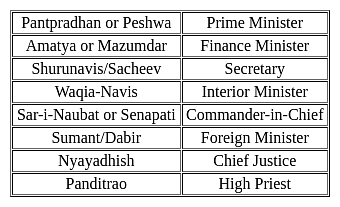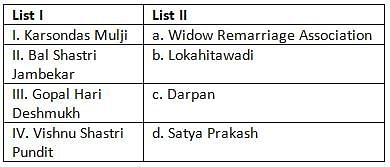TS SET Paper 2 Mock Test - 2 (History) - TS TET MCQ
30 Questions MCQ Test TS SET Mock Test Series 2024 - TS SET Paper 2 Mock Test - 2 (History)
Which of the following Vedas contains the famous Gayatri - Mantra ?
Match the following.
State
I. Awadh
II. Hyderabad
III. Bengal
IV. Kerela
Founder
a. Nizam-ul-Mulk Asaf Jha
b. Murshid Quli Khan
c. Saadat Khan Burhan-ul-Mulk
d. Martanda Varma
State
I. Awadh
II. Hyderabad
III. Bengal
IV. Kerela
a. Nizam-ul-Mulk Asaf Jha
b. Murshid Quli Khan
c. Saadat Khan Burhan-ul-Mulk
d. Martanda Varma
| 1 Crore+ students have signed up on EduRev. Have you? Download the App |
Which of the following about Minto-Morley reforms is not correct?
1) The act provided for non-official majority in the provincial Legislatures
2) It divided the Provincial administration subjects into reserved and transferred subjects
- Introduction of cash crops at the expense of subsistence crops
- Heavy taxation and land revenue systems
- Natural environmental fluctuations
- Immediate post-independence economic policies
- The effective response of the colonial administration
- The loss of millions of lives
- Being largely attributed to British colonial policies
The response and policies of the British colonial administration regarding famines and epidemics were characterized by:
- Proactive and timely interventions
- Systemic neglect and underinvestment in public health infrastructure
- Scathing criticism from historians
- Significant efforts to address food security
Subhash Chandra Bose fought the Congress Presidential elections in 1939 on the ground that
Match the following.
List I
I. Mir-i-Atish
II. Mir-i-Bahari
III. Mir-i-Askan
IV. Waqa-i-Nawis
List II
a. in-charge of Navy
b. in-charge of military offences
c. Royal Correspondent
d. in-charge of artillery
The British East India Company was formed during the reign of which of the following ruler?
Consider the following statements:
- Adi Brahmo Sabha was founded by Raja Ram Mohan Roy in Kolkata.
- All India Brahmo Samaj was founded by Debendranath Tagore.
- Sadharan Brahmo Samaj was founded by Anand Mohan Bose and Kesab Chandra Sen.
Choose the incorrect statements.
With reference to Cholas, consider the following statements:
1. Karikala Chola established the city of Puhar at the mouth of river Cauvery.
2. Parantaka I captured the capital city of Pandyas- Madurai and assumed the title of ‘Maduraikonda’.
3. Under the Rajendra I kingship, colas annexed northern Sri Lanka.
4. Rajaraja I defeated Mahinda V and annexed the whole of Sri Lanka in 1018 A.D.
How many of the statements given above are correct?
Navdatoli, Eran and Nagada are the three best known settlements of
The English edition of ‘Gitanjali’ was published in the year-
Which of the following was the British residence in Awadh at the time of its annexation into British dominion?
Who of the following Muslim leaders called the partition as ‘an act of treachery on the part of Congress’.
In Oswald Spengler's Cyclical Theory of History, which of the following statements are CORRECT?
(a) Each culture goes through distinct stages of growth, maturity, decline, and eventual death.
(b) Spengler believed Western Civilization had already reached its peak and was entering a period of decline.
(c) Unlike some cyclical theories, Spengler did not posit the possibility of rebirth or renewal for cultures.
(d) Spengler's theory emphasized the role of technology and economic factors as the driving forces of historical change.
A. Aurobindo Ghosh
B. Bal gangadhar Tilak
C. Phirozeshah Mehta
D. Lala lajpat rai
Which of the following group represents extremists group.
Consider the following statements about Raja Ram Mohan Roy and select the incorrect one:
In the context of recent trends in Indian historiography, which of the following statements are CORRECT?
(a) There's a growing emphasis on the environmental history of India, examining how humans interacted with and shaped their ecological surroundings.
(b) Historians are increasingly employing digital tools and methodologies for data analysis, historical mapping, and public outreach.
(c) Studies on emotions and subjective experiences are gaining traction, moving beyond purely economic or political interpretations of the past.
(d) The focus has shifted away from studying the history of elites and institutions, with a renewed interest in the lives and experiences of marginalized communities.
|
60 tests
|














